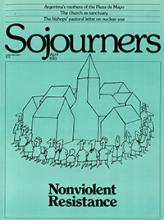We are in the midst of a very rapid and large shift in human consciousness regarding questions of war and peace. As recently as 1980, one of the main preoccupations of the peace movement was how to inform and arouse the public about the dangers of nuclear war. Given the current front-page stories on the nuclear issue, it is hard to remember that the 1970s saw very little public discussion of the nuclear peril. Very few church bodies or religious leaders were speaking out. No mass movement was addressing itself to stopping the arms race.
Now the concern is so widespread that one commentator estimates that the peace and anti-nuclear movements have involved a greater number of people from a wider variety of backgrounds in more countries than any other issue of our century. In the United States more than 11 million citizens have voted in favor of a nuclear freeze. And the largest demonstration in U.S. history addressed itself to disarmament on June 12, 1982, in New York City.
Hundreds of thousands of Europeans have demonstrated for the same cause. Millions of people around the world are deeply concerned and are becoming active in disarmament advocacy. Religious leaders have come out so strongly that U.S. News and World Report describes them as "the key force behind the American anti-war crusade." This burst of interest and activity has come about in less than three years.
These millions of newly involved peace advocates are looking for practical answers as to how the world can back away from the nuclear abyss. If they find meaningful answers and creative ways to act, they will stay involved and will draw in others. Their involvement in the nuclear freeze movement shows the power of a creative idea to involve people in meaningful, large-scale peace action.
Read the Full Article

